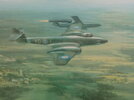Sliding Off Subject Again.
Sid, I like the fact that a Spitfire could catch up with Natzi V-I buzzer..... tip it's wing, and cause it to crash where it would do no damage!
Sid, I like the fact that a Spitfire could catch up with Natzi V-I buzzer..... tip it's wing, and cause it to crash where it would do no damage!

